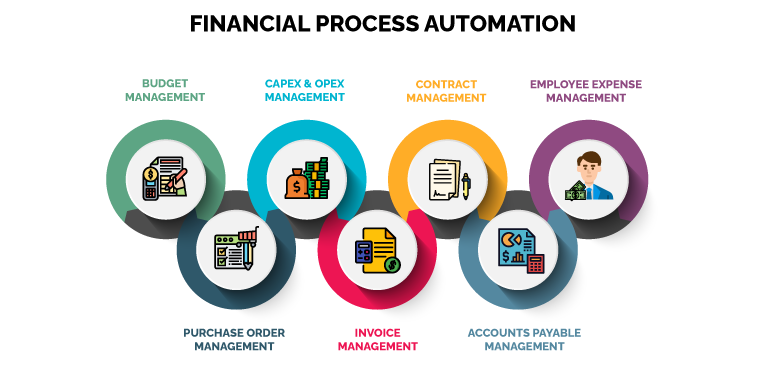
We all know finances are the backbone of any and every business. Regardless of the industry, financial efficiency and effectiveness obviously lead to growth and success. And with no-code business process management (BPM) platforms available in the market, achieving it is not difficult; trust us. Businesses across departments and industries are exploring no-code platforms for Financial Process Automation to streamline accounts and finance processes. Automating processes takes only a few days with no-code, and voila! All weary accountants amidst manual calculations and redundant processes are going to rejoice.
Did you know?
According to the Accenture Finance report, financial process automation would eliminate up to 40% of the transactional accounting work that the finance department does today! Isn’t that awesome when almost half of your work is automated? This means the team can open so many other windows to create business value by giving more time to decision-making, predictive analysis, and performance management.
Let’s understand what Financial Process Automation is and do for us all!
What is Financial Process Automation?
Adopting automation is no longer a choice but a strategic imperative. Financial Process Automation (FPA) heralds a new era, transforming traditional workflows into streamlined, error-free processes. From compliance to customer service, FPA is revolutionizing how financial institutions operate. Join us as we delve into the intricacies, benefits, and future landscape of Financial Process Automation, where efficiency meets innovation. Welcome to the forefront of financial excellence.
What Is No-Code Financial Process Automation?
No-code financial process automation refers to the use of visual, drag-and-drop platforms that allow finance professionals to build, customize, and deploy automated workflows—without writing a single line of code. These platforms empower teams to digitize repetitive and manual financial tasks such as invoice approvals, expense tracking, payroll processing, and report generation using a simple interface rather than traditional programming.
The key benefit of no-code tools is accessibility. Traditionally, automation projects required developers, IT support, and long development cycles. With no-code platforms, finance teams themselves can create and adapt workflows in response to evolving business needs—eliminating delays and reducing dependency on technical teams. This democratization of automation allows businesses to move faster, reduce operational costs, and increase accuracy across financial functions.
No-code automation enhances compliance and transparency. Built-in logic, audit trails, and integration capabilities help ensure that processes follow policy and regulatory guidelines. Whether you’re a CFO seeking real-time insights or an accounts manager looking to eliminate bottlenecks, no-code platforms offer an intuitive and scalable way to modernize financial operations with minimal disruption.
Essential Financial Processes to Automate
Let’s look at what Financial Process Automation can do to boost your product and service mix and transform your business through 2 lenses- Service & Business.
Obviously, a boost in service and product will transform business and make it successful but it’s still crucial to understand the distinguishable factors affecting both.
Let’s look at where FPA can boost your services and the processes involved in delivering them!

1. Budget Management
Financial Process Automation helps you get rid of inefficient excel based budget spreadsheets. We all know how much time is spent on spreadsheets per week, and trust us, it costs a bomb, time and energy-wise too!
Instead, automate the budget approval process and track employees’ usage of financial resources. You should and can build a custom dashboard with the reports and charts to get insights that you need for efficient tracking and decision-making and get that budget bang-on!
Also Read: Budget Planning & Expense Tracking Solution for Informed Decisions
2. Purchase Order Management
Filling out purchase orders in spreadsheets every time is not the most interesting task, right? So, just automate the purchase order workflow, including indent submission, approval, and purchase order issuance. You can generate purchase orders from the system, too, and there, you’ve just reduced so many possible manual errors!
3. CapEx and OpEx Management
We know CapEx & OpEx management is your thing, but how about making it easier? Manage and streamline all CapEx and OpEx request submissions and approvals through automated workflows as per your company’s processes and policies. The real deal is the analysis, and let’s give that clarity and a proper overview with the use of advanced reports and dashboards over any period.
4. Invoice Management
Invoices from all over the company may become a bit too much to handle. So, streamline both incoming and outgoing invoice management processes through automated workflows that take care of necessary verifications and approvals. Simply generate invoices from the system to avoid any errors from manual entry. And don’t miss out on payments by sending out automated email and SMS alerts for pending payments.
5. Contract Management
Poorly managed contracts can create huge financial liability for the company. Streamline your end-to-end contract lifecycle, including receipt, review, approval, signing, and storage of contract documents.
Also Read: Enhancing Efficiency and Security: Tracking IT Assets in Banking Branches
6. Accounts Payable Management
Ensuring your business’s invoices and bills are paid properly is also one of the most important jobs out there. Automate accounts payable processes and other finance workflow automation.
You can make sure that all the bills are paid on time in an organized manner without any duplicate payments. And simply make your process paperless and reduce manual effort.
Also Read: Use-Cases of No-Code in Extending Digital Banking Services
7. Accounts Receivable (AR)
The accounts receivable process involves generating and tracking invoices, sending payment reminders, and reconciling incoming funds. Automation in this area ensures that invoices are sent out promptly, follow-ups are systematic, and payments are accurately recorded. As a result, businesses experience faster collections and better financial predictability.
8. Employee Expense Management
Payroll can be too complex to manage manually. Not only do you have different salary levels to account for: but there are also holiday entitlements, employee expense sheets, etc., to account for!
Enable employees to submit expense claims through the self-service portal. They can upload travel expenses along with supporting bills using any device from anywhere. And don’t worry about approvals and verification because you can automate it as per company processes and procedures for the swift processing of claims. And because of automation, avoid those unnecessary errors from manual processing.
Automate expense management process to receive, verify, and process these claims and eliminate paper trails to reduce manual effort. You can also collect Income Tax Savings declarations from employees to calculate tax deductions for payroll processing.
9. Payroll Processing
Payroll automation handles salary calculations, deductions, tax filings, and direct deposits with minimal human intervention. Automating payroll ensures employees are paid accurately and on time, while also reducing compliance risks and administrative overhead. It allows HR and finance teams to focus on strategic tasks rather than repetitive processing.
10. Financial Reporting
Automated financial reporting pulls data from various systems to generate accurate, up-to-date financial statements and dashboards. This reduces the time spent on manual data gathering and eliminates the risk of inconsistencies. With real-time insights, decision-makers can act faster and with greater confidence.
11. Budgeting & Forecasting
Automation in budgeting and forecasting helps teams collect data from multiple departments, build financial models, and conduct scenario analyses more efficiently. It enhances collaboration, reduces planning cycles, and allows for more agile adjustments in response to market changes or internal shifts.
12. Tax Compliance
Managing taxes involves complex calculations, ever-changing regulations, and strict deadlines. Automating tax compliance helps ensure accurate tax calculations, timely filings, and organized documentation for audits. This reduces the risk of penalties and frees up valuable time for finance teams to focus on strategy.
13. Procure-to-Pay (P2P)
The procure-to-pay cycle includes creating purchase requisitions, obtaining approvals, generating purchase orders, receiving goods, and processing invoices. Automating this process improves procurement efficiency, reduces maverick spending, and enhances visibility into every stage of procurement, ultimately supporting better cost control.
14. Order-to-Cash (O2C)
From order placement to revenue collection, the order-to-cash process can benefit greatly from automation. Streamlining order entry, billing, credit management, and collections results in faster revenue recognition and better customer satisfaction. It also minimizes manual intervention, which often causes delays and errors.
15. Audit Preparation
Preparing for audits typically involves collecting and organizing a vast amount of documentation. By automating audit-related processes, such as maintaining an audit trail, logging approvals, and standardizing report generation, organizations can reduce stress, improve accuracy, and ensure a smoother audit experience.
16. Bank Reconciliation
Manually matching internal financial records with bank statements is a tedious task. Automation simplifies this process by quickly identifying discrepancies and reconciling accounts with precision. This not only accelerates the monthly close but also helps maintain accurate cash flow records.
17. Fixed Asset Management
Tracking the acquisition, depreciation, and disposal of fixed assets manually can lead to errors and missed updates. Asset management automation ensures that asset records are always current, depreciation schedules are correctly applied, and compliance requirements are met. It also enhances reporting accuracy for financial and tax purposes.
Also read: A Complete Guide to Workflow Automation Software
Benefits of No-Code Finance Process Automation
1. All the Time for Strategic Initiatives
By embracing the automation of routine accounting, administration, and compliance tasks, you can free up time, and teams can deliver global operational efficiencies and be leaders for growth. With financial process automation, you can reduce operational costs and shine a light on new avenues of growth by making more time for strategic initiatives that drive value and profits.
2. Ensuring Substantial Consistency
At the end of the day, each human is different and their way of doing things- even if it’s doing the same task. Even standard processes, such as double-entry bookkeeping, can differ among people. Automating processes ensures greater consistency within teams, reducing the chances of mistakes and information gaps and having a standard procedure.
3. Risk assessment
Financial risks, if not assessed, can cost you a whole company! We all know the dangers of not analyzing risks! With the best Financial Process Automation, you can actually access the most accurate and timely information from throughout the organization, and you’ll be able to run scenarios of different variable sets – such as interest rate, inflation, or currency fluctuations – to determine both potential risks in existing markets and prospects in new ones. Over time, FPA will automatically assess risks and minimize them!
Also Read: No-Code in the FMCG Industry: A New Era of Innovation
4. Enable global expansion
Having a global reputation and presence indicates growth and leadership across companies, and to achieve that, FPA plays a big role! Automated financing functions allow corporate finance to comply with regulations in various countries, provide multi-language and multi-currency support, and automatically support the accounts of subsidiary companies.
5. Embrace Opportunity

The end of a good story is a happy ending, but guess what? FPA isn’t even the end of the story but the beginning of a better and enhanced workspace!
The automation of finance brings a great deal of innovation and practical transformations that will continue to drive technological advancements right before our eyes. And that is something we can all invest in.
Now, we know what you might think: so many benefits and advantages, but where do I start with FPA? And as FPA has got you covered, so have we!

Also Read: Top 10 No-Code Startups Disrupting Industries
How No-Code Low-Code Financial Process Automation Systems Can Help
No-code and low-code financial process automation systems enable finance teams to streamline their operations without relying heavily on software developers. By providing intuitive interfaces, pre-built templates, and drag-and-drop functionality, these platforms make it possible to design and implement complex financial workflows with minimal technical expertise. This not only reduces the time and cost involved in automation projects but also allows finance departments to be more agile and responsive to changes.
For example, tasks like invoice processing, budget approvals, compliance checks, and financial reporting can all be automated with simple visual workflows. Instead of manually entering data across spreadsheets or waiting on email approvals, teams can create seamless, rule-based systems that trigger actions automatically—ensuring consistency and reducing the risk of human error.
Low-code platforms take it a step further by offering customizable code snippets or logic blocks for users who have some technical knowledge and need more flexibility. This hybrid approach is particularly useful for organizations with complex financial needs, allowing for deeper integrations with ERP systems, CRM tools, or third-party financial software.
Ultimately, these systems improve accuracy, boost productivity, enhance transparency, and strengthen compliance—all while empowering finance professionals to build solutions tailored to their own unique processes. As a result, businesses can shift from reactive, manual financial management to a more proactive and strategic approach.
How to Start Automation in Financial Services?
Picture a world where the complexities of financial processes are simplified and operational efficiency takes center stage. This transformation is not fueled by grand gestures but by the subtle power of no-code and low-code automation tools. Learn how these unassuming tools quietly reshape the future of financial operations, one automated task at a time. Welcome to a new era of sophistication and efficiency in finance.
1. Assess Current Processes: Identify the mundane tasks that desperately seek a touch of magic. With no-code and low-code, turn the ordinary into the extraordinary.
2. Define Objectives: Clearly articulate your financial wishes – from faster processing times to impeccable customer service. Let no-code and low-code be your magical companions in achieving these aspirations.
3. Select the Right Tools: Choose tools that resonate with the financial spell you wish to cast. No-code and low-code options are your magical artifacts, offering flexibility and customization at your command.
4. Start with Low-Risk Processes: Dip your toes into the magical waters with low-risk, routine processes. Watch as no-code and low-code unveil quick wins, creating a ripple of enchantment.
5. Ensure Data Security and Compliance: Guard your financial kingdom with the shields of data security and compliance. Choose no-code and low-code platforms that stand as guardians of industry standards.
6. Implement Robotic Process Automation (RPA): Unleash robotic allies through no-code and low-code solutions for tasks like data entry and invoice processing. Witness seamless operations as if guided by invisible hands.
7. Workflow Automation: Let the enchantment of workflow automation spread across your financial realm. With no-code and low-code wands, orchestrate processes with harmonious collaboration.
8. Intelligent Document Processing: Conjure the wisdom of intelligent document processing using no-code and low-code prowess. Extract information effortlessly, as if deciphering magical scrolls.
Also Read: How Financial Management Systems Save You Time & Money
9. Employee Training: Illuminate your team with the brilliance of automated processes crafted with no-code and low-code. Empower them to dance alongside the magic, ensuring a smooth transition.
10. Continuous Monitoring and Optimization: Be the vigilant wizard, regularly monitoring and optimizing spells cast with no-code and low-code. Adapt and refine as if tweaking the incantations for better outcomes.
11. Expand Automation Gradually: Like a wizard honing new spells, gradually expand automation using no-code and low-code wonders. Witness scalable magic, evolving with each enchanting step.
12. Measure and Analyze: Set the enchanted compass to measure the impact of your magic. Analyze the key performance indicators guided by no-code and low-code efficiency.
13. Customer-Centric Approach: Direct the magic towards customer experiences. Automate processes impacting interactions with the finesse of no-code and low-code, creating a symphony of delight.
14. Collaborate with Experts: Seek wisdom from fellow wizards – automation experts with mastery in no-code and low-code. Collaborate to weave intricate spells tailored to financial services.
As you navigate through financial enchantment, let the LCNC magic unwrap, turning every challenge into an opportunity for financial wizardry!
Also Read: Navigating Automation Challenges in BFSI Industry
How Quixy’s Custom App Development Platform Can Help in Financial Automation
Quixy is a robust no-code low-code application development platform that empowers business users and IT teams to automate processes and build custom applications without writing traditional code. Designed to bridge the gap between business needs and technical execution, Quixy offers a visual interface with drag-and-drop tools, reusable components, and powerful integrations—making digital transformation faster, more accessible, and highly customizable.
At its core, Quixy allows organizations to move beyond spreadsheets and manual workflows by enabling the creation of tailored apps for tasks such as approvals, data management, reporting, and more. Whether you’re automating a simple finance approval flow or building a complex procurement system, Quixy provides the flexibility to configure solutions that fit your exact requirements—without the delays of conventional software development.
For finance teams in particular, Quixy streamlines critical operations like expense management, accounts payable, invoice processing, budgeting, and compliance tracking. With features like form builders, automated workflows, role-based access controls, and real-time dashboards, the platform ensures accuracy, consistency, and speed across every financial process.
Moreover, Quixy integrates easily with existing systems such as ERPs, CRMs, and accounting tools, helping create a seamless, end-to-end automation environment. By reducing dependency on IT and empowering teams to innovate independently, Quixy transforms how organizations approach process efficiency and digital agility.
Conclusion
To foresee is to succeed, and that’s what financial process automation does for you! It paves the way for a better workplace by giving you the time to do all the brainy strategic work. It ensures that your team will spend more of their time developing high-value, forward-looking businesses and that your team has the opportunity to be one of your organization’s most significant strategic advantages.
And before you start thinking, where do I get all of this and which is the best platform to look at, we’ve got something for you!
Quixy is an innovative, top-performing, no-code platform that specializes in financial process automation. Quixy’s platform helps you automate any business process and build simple to complex enterprise-grade applications in hours and days instead of weeks and months, all without writing any code.
Ready to transform your business? Get started now and experience the power of automation and app creation, all without the need for coding skills.
Frequently Asked Questions(FAQs)
What is an example of financial automation?
An example of financial automation is automating the process of invoice processing. Instead of manually entering and approving invoices, financial management software can scan and process them, reducing human effort and errors.
Why automate finance processes?
Automating finance processes streamlines tasks like data entry, payment processing, and reconciliation. It reduces errors, speeds up operations, and allows finance teams to focus on strategic activities.
What is financial automation?
Financial automation involves using technology to automate routine financial tasks, such as invoicing, payroll, and expense management, to improve efficiency and accuracy.
How do banks use automation?
Banks use automation for various tasks, including transaction processing, account management, fraud detection, and customer service. It enhances speed and accuracy while reducing operational costs.
Is automation a FinTech?
Automation is a part of FinTech (Financial Technology). FinTech encompasses a wide range of technologies and innovations in the financial sector, with automation being one of the tools that drive efficiency and customer service.
Login
Please login to comment
0 Comments
Oldest















